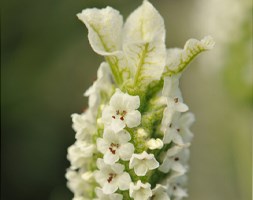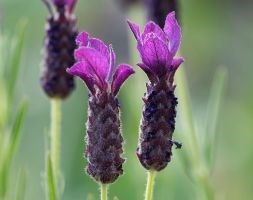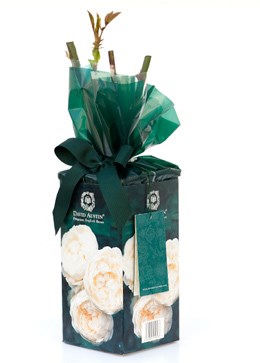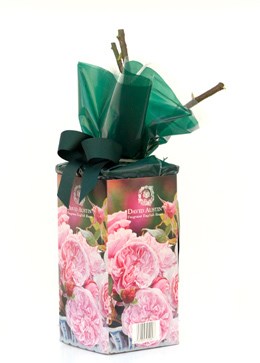Price reductions at Crocus
by Sarah - April 17th, 2014.Filed under: Crocus, Price Reductions.
Crocus has cut the price of these lines
Lavandula stoechas subsp. stoechas f. leucantha ‘Snowman’ (white French lavender) was £9.99 now £7.99
Position: full sun Soil: moderately fertile, well-drained soil Rate of growth: average Flowering period: June and July Hardiness: borderline hardy (may need winter protec tion) As the name suggests, this French lavender has spikes of pure white flowers, topped with distinctive white, butterfly-like tufts from late spring to summer and grey-green, aromatic leaves. It makes a striking feature planted en masse as a fragrant edging for a sunny, protected border, along a path or in a container. Like most French lavenders, this is earlier flowering than its English cousins, but associates well with them if you want to prolong the season of lavender in your garden. The flower-spikes are also a magnet for bees and other beneficial insects. In frost-prone areas it is best grown in a large container and over-wintered indoors. As it’s borderline hardy it is best grown in a container in colder areas of the country and should be over-wintered in a cool greenhouse or conservatory. Garden care: Cut back the stalks after the flowers have faded to retain a compact shape. Carefully trim back in April, taking care not to cut into old wood.
Lavandula ‘Regal Splendour’ (PBR) (French lavender) was £9.99 now £7.99
Position: full sun Soil: moderately fertile, well-drained soil Rate of growth: average Flowering period: April to May Hardiness: borderline hardy (may need winter protection) From fat round flowerheads, delicate, upright flags emerge like butterfly wings and flutter in the breeze among grey-green aromatic leaves. This French lavender has dark purple flowers and looks wonderful planted en masse in a protected, sunny border where its heady fragrance can be enjoyed. Like most French lavenders, it is earlier flowering than its English cousins, but associates well with them if you want to prolong the season of lavender in your garden. The flower-spikes are also a magnet for bees and other nectar-loving insects. As it’s borderline hardy it is best grown in a container in colder areas of the country and should be over-wintered in a cool greenhouse or conservatory. Garden care: Cut back the stalks after the flowers have faded to retain a compact shape. Carefully trim back in April, taking care not to cut into old wood.
Rose gift Pack ‘Lichfield Angel’ (‘Lichfield Angel’ Gift Pack) was £17.99 now £12.99
Position: full sun Soil: fertile, humus-rich, moist, well-drained soil Rate of growth: average Flowering period: June and September Flower colour: blush pink Other features: excellent cut flowers Hardiness: fully hardy Deeply cupped, apricot-flushed roses turn creamy white and open fully as they mature to reveal their mass of petals. Their perfume changes too as the flowers age, taking on a rich clove-like undertone. It is noted for its ability to produce an abundance of bloom throught summer and into autumn, while its soft colouring ensures it fits easily into most planting schemes. A very beautiful rose, which comes in a 2 litre pot. It will be delivered in a colourful gift box and tied with ribbon. Garden care: If planting out in winter, choose a frost-free spell when the soil is not frozen. Roses are quite deep-rooted plants so dig a deep hole roughly twice as wide as the plants roots and mix in a generous amount of composted organic matter. A top-dressing of a general purpose fertiliser can be worked into the surrounding soil and we also recommend using Rose Rootgrow at this stage to encourage better root development. This is particularly important when planting into a bed where roses have previously been grown as Rose Rootgrow is said to combat rose sickness (aka. replant disease). Remove the plants from their pots and gently spread out the roots before placing them in the centre of the hole. Try to ensure that the ‘bud union’ (the point where the cultivated rose has been grafted onto the rootstock, and from where the shoots emerge) is at soil level. You can judge this quite easily by laying something flat, like a spade handle or bamboo cane, across the top of the hole. When they are at the right height, back-fill the hole, firming the soil down gently before watering the plant well. Water generously until well established, and apply a specialist rose fertiliser (following the manufacturers instructions) each spring. They will also benefit from a generous mulch of composted farmyard manure in spring, but make sure this is kept away from the stems. In late winter, pop on a pair of tough gloves and remove dead, damaged, diseased or congested branches completely. Then cut back vigorous new shoots by up to a third, and shorten strong side-shoots to within two or three buds of the main stems. If the centre of the shrub is becoming congested, remove one or two of the older stems to their b
Rose Gift Pack ‘Gentle Hermione’ (‘Gentle Hermione’ Gift Pack) was £17.99 now £12.99
Position: full sun Soil: fertile, humus-rich, moist, well-drained soil Rate of growth: average Flowering period: June and September Flower colour: blush pink Other features: excellent cut flowers Hardiness: fully hardy A particularly beautiful rose, with richly scented blooms that make wonderful additions to the vase. Each flower is crowded with lots of pink petals that are encased by several rows of slightly paler outer petals. The overall effect is very pretty, and as they stand up well to rain, they tend to last well, both on the well-rounded shrub, or after cutting. This gorgeous rose, comes in a 2 litre pot and will be delivered to the lucky recipient in a colourful gift box and tied with ribbon. Garden care: If planting out in winter, choose a frost-free spell when the soil is not frozen. Roses are quite deep-rooted plants so dig a deep hole roughly twice as wide as the plants roots and mix in a generous amount of composted organic matter. A top-dressing of a general purpose fertiliser can be worked into the surrounding soil and we also recommend using Rose Rootgrow at this stage to encourage better root development. This is particularly important when planting into a bed where roses have previously been grown as Rose Rootgrow is said to combat rose sickness (aka. replant disease). Remove the plants from their pots and gently spread out the roots before placing them in the centre of the hole. Try to ensure that the ‘bud union’ (the point where the cultivated rose has been grafted onto the rootstock, and from where the shoots emerge) is at soil level. You can judge this quite easily by laying something flat, like a spade handle or bamboo cane, across the top of the hole. When they are at the right height, back-fill the hole, firming the soil down gently before watering the plant well. Water generously until well established, and apply a specialist rose fertiliser (following the manufacturers instructions) each spring. They will also benefit from a generous mulch of composted farmyard manure in spring, but make sure this is kept away from the stems. In late winter, pop on a pair of tough gloves and remove dead, damaged, diseased or congested branches completely. Then cut back vigorous new shoots by up to a third, and shorten strong side-shoots to within two or three buds of the main stems. If the centre of the shrub is becoming congested, remove one or two of the older stems to their










